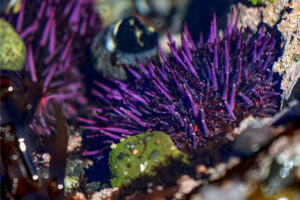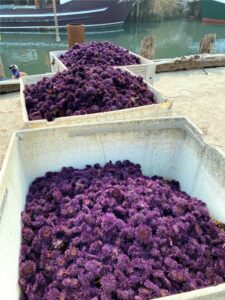Urchin Removal on the North Coast Shows Promising Results for Kelp Forest Restoration

Photo: Stacy Hayden/Ocean Protection Council
June 28, 2022
FOR IMMEDIATE RELEASE
Contact:
Mike Esgro, (818) 917-6468, Michael.Esgro@resources.ca.gov
Urchin Removal on the North Coast Shows Promising Results for Kelp Forest Restoration
Fort Bragg, Calif. – An unprecedented partnership on California’s north coast has concluded with the removal of nearly 50,000 pounds of purple urchins and positive signs of kelp forest recovery. The exciting results from two Mendocino County restoration sites demonstrate that commercial urchin fishermen can be extremely effective at targeted urchin removals, and that removals can facilitate bull kelp recovery when oceanographic conditions are favorable. The promising outcomes from this two-year effort will inform resource managers’ efforts to protect and restore threatened kelp forests across the state.

Photo: Mike Esgro/Ocean Protection Council
California’s kelp forests are among the most iconic, productive, and biodiverse marine ecosystems on the planet. But these unique places are also highly vulnerable to climate change. On California’s north coast, more than 95 percent of bull kelp was lost between 2014 and 2019 as a result of changing ocean conditions that included warmer waters, the emergence of sea star wasting disease, and an explosion in kelp-eating native purple sea urchin populations. In 2020, OPC and the California Department of Fish and Wildlife led the charge to protect and restore north coast kelp through a bold, “no-regrets” action that authorized nearly $500,000 (PDF) to fund removal of purple urchins in support of bull kelp restoration at two sites in Mendocino County. This project represented an unprecedented collaboration between state government, nonprofit organizations (including Reef Check Worldwide, The Nature Conservancy, the Noyo Center for Marine Science, and Watermen’s Alliance), and local communities, particularly commercial red urchin fishermen whose livelihoods were devastated by kelp collapse.
Despite serious challenges posed by the COVID-19 pandemic, fishermen successfully reduced urchin densities to fewer than two per square meter (the threshold expected to allow kelp to recover). The urchin removal efforts appear to have had a positive impact on kelp. Monitoring conducted by Reef Check showed a significant increase in bull kelp density at the Noyo Bay restoration site, while no such response was observed at the control site, even though waters began to cool across the region in 2021.
This urchin removal pilot project provides valuable insight into costs, logistical considerations, and best practices associated with this restoration method, particularly for bull kelp ecosystems on the north coast. As California works toward more proactive, climate-ready kelp forest management (PDF), urchin removal by commercial fishermen will be incorporated into a kelp restoration “toolkit” being developed by resource managers. Next steps will include exploring the feasibility of scaling up this work to other sites on the north coast and beyond. The overall success of the effort will be determined in the years to come.
For more details, please read the full report: Restoration of Northern California Bull Kelp Forests (PDF).
***
About the California Ocean Protection Council:
The Ocean Protection Council is a state agency whose mission is to ensure that California maintains healthy, resilient, and productive ocean and coastal ecosystems for the benefit of current and future generations. The Council was created pursuant to the California Ocean Protection Act. For more information, and for a link to OPC’s 2020-2025 Strategic Plan to Protect California’s Coast and Ocean, visit www.opc.ca.gov.

